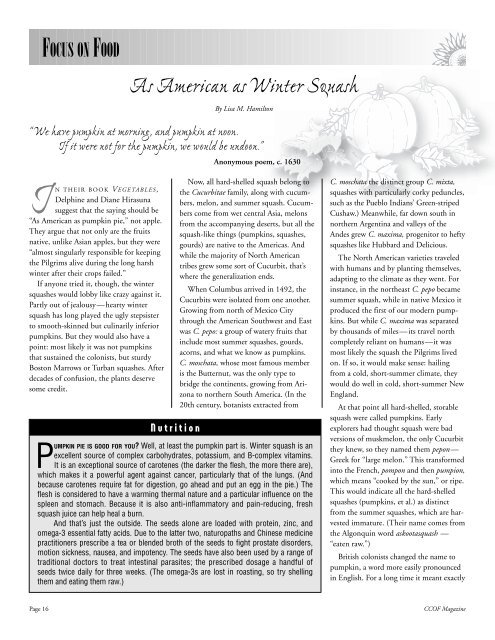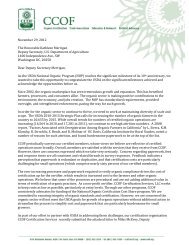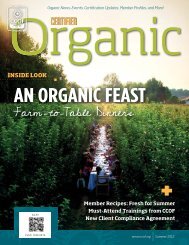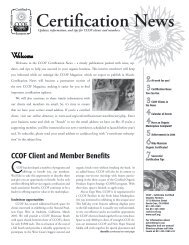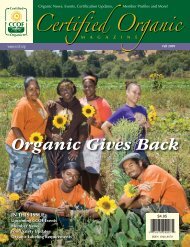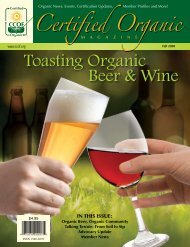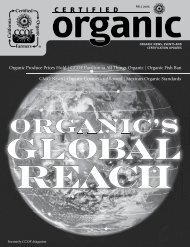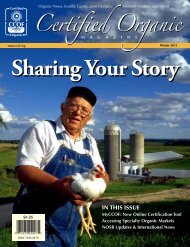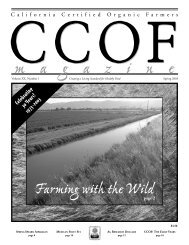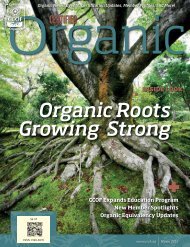FOCUS ON FOODAs American as W<strong>in</strong>ter SquashBy Lisa M. Hamilton“We have pumpk<strong>in</strong> at morn<strong>in</strong>g, and pumpk<strong>in</strong> at noon.If it were not for the pumpk<strong>in</strong>, we would be undoon.”Anonymous poem, c. 1630IN THEIR BOOK V EGETABLES,Delph<strong>in</strong>e and Diane Hirasunasuggest that the say<strong>in</strong>g should be“As American as pumpk<strong>in</strong> pie,” not apple.They argue that not only are the fruitsnative, unlike Asian apples, but they were“almost s<strong>in</strong>gularly responsible for keep<strong>in</strong>gthe Pilgrims alive dur<strong>in</strong>g the long harshw<strong>in</strong>ter after their crops failed.”If anyone tried it, though, the w<strong>in</strong>tersquashes would lobby like crazy aga<strong>in</strong>st it.Partly out of jealousy—hearty w<strong>in</strong>tersquash has long played the ugly stepsisterto smooth-sk<strong>in</strong>ned but cul<strong>in</strong>arily <strong>in</strong>feriorpumpk<strong>in</strong>s. But they would also have apo<strong>in</strong>t: most likely it was not pumpk<strong>in</strong>sthat susta<strong>in</strong>ed the colonists, but sturdyBoston Marrows or Turban squashes. Afterdecades of confusion, the plants deservesome credit.NutritionNow, all hard-shelled squash belong tothe Cucurbitae family, along with cucumbers,melon, and summer squash. Cucumberscome from wet central Asia, melonsfrom the accompany<strong>in</strong>g deserts, but all thesquash-like th<strong>in</strong>gs (pumpk<strong>in</strong>s, squashes,gourds) are native to the Americas. Andwhile the majority of North Americantribes grew some sort of Cucurbit, that’swhere the generalization ends.When Columbus arrived <strong>in</strong> 1492, theCucurbits were isolated from one another.Grow<strong>in</strong>g from north of Mexico Citythrough the American Southwest and Eastwas C. pepo: a group of watery fruits that<strong>in</strong>clude most summer squashes, gourds,acorns, and what we know as pumpk<strong>in</strong>s.C. moschata, whose most famous memberis the Butternut, was the only type tobridge the cont<strong>in</strong>ents, grow<strong>in</strong>g from Arizonato northern South America. (In the20th century, botanists extracted fromPUMPKIN PIE IS GOOD FOR YOU? Well, at least the pumpk<strong>in</strong> part is. W<strong>in</strong>ter squash is anexcellent source of complex carbohydrates, potassium, and B-complex vitam<strong>in</strong>s.It is an exceptional source of carotenes (the darker the flesh, the more there are),which makes it a powerful agent aga<strong>in</strong>st cancer, particularly that of the lungs. (Andbecause carotenes require fat for digestion, go ahead and put an egg <strong>in</strong> the pie.) Theflesh is considered to have a warm<strong>in</strong>g thermal nature and a particular <strong>in</strong>fluence on thespleen and stomach. Because it is also anti-<strong>in</strong>flammatory and pa<strong>in</strong>-reduc<strong>in</strong>g, freshsquash juice can help heal a burn.And that’s just the outside. The seeds alone are loaded with prote<strong>in</strong>, z<strong>in</strong>c, andomega-3 essential fatty acids. Due to the latter two, naturopaths and Ch<strong>in</strong>ese medic<strong>in</strong>epractitioners prescribe a tea or blended broth of the seeds to fight prostate disorders,motion sickness, nausea, and impotency. The seeds have also been used by a range oftraditional doctors to treat <strong>in</strong>test<strong>in</strong>al parasites; the prescribed dosage a handful ofseeds twice daily for three weeks. (The omega-3s are lost <strong>in</strong> roast<strong>in</strong>g, so try shell<strong>in</strong>gthem and eat<strong>in</strong>g them raw.)C. moschata the dist<strong>in</strong>ct group C. mixta,squashes with particularly corky peduncles,such as the Pueblo Indians’ Green-stripedCushaw.) Meanwhile, far down south <strong>in</strong>northern Argent<strong>in</strong>a and valleys of theAndes grew C. maxima, progenitor to heftysquashes like Hubbard and Delicious.The North American varieties traveledwith humans and by plant<strong>in</strong>g themselves,adapt<strong>in</strong>g to the climate as they went. For<strong>in</strong>stance, <strong>in</strong> the northeast C. pepo becamesummer squash, while <strong>in</strong> native Mexico itproduced the first of our modern pumpk<strong>in</strong>s.But while C. maxima was separatedby thousands of miles—its travel northcompletely reliant on humans—it wasmost likely the squash the Pilgrims livedon. If so, it would make sense: hail<strong>in</strong>gfrom a cold, short-summer climate, theywould do well <strong>in</strong> cold, short-summer NewEngland.At that po<strong>in</strong>t all hard-shelled, storablesquash were called pumpk<strong>in</strong>s. Earlyexplorers had thought squash were badversions of muskmelon, the only Cucurbitthey knew, so they named them pepon—Greek for “large melon.” This transformed<strong>in</strong>to the French, pompon and then pumpion,which means “cooked by the sun,” or ripe.This would <strong>in</strong>dicate all the hard-shelledsquashes (pumpk<strong>in</strong>s, et al.) as dist<strong>in</strong>ctfrom the summer squashes, which are harvestedimmature. (Their name comes fromthe Algonqu<strong>in</strong> word askootasquash —“eaten raw.”)British colonists changed the name topumpk<strong>in</strong>, a word more easily pronounced<strong>in</strong> English. For a long time it meant exactlyPage 16<strong>CCOF</strong> Magaz<strong>in</strong>e
what it’s supposed to, but at some po<strong>in</strong>tthere was a split. The Irish imported thetradition of Jack-o-Lanterns, which theyhad previously carved from turnips andpotatoes but (for obvious reasons) switchedto the pumpk<strong>in</strong> upon arriv<strong>in</strong>g <strong>in</strong> America.This has come to be the new def<strong>in</strong>ition of apumpk<strong>in</strong>—smooth and bright orange,with th<strong>in</strong> sk<strong>in</strong> and thick seeds. We still eatsome pumpk<strong>in</strong>s, but most often they arebred for October’s non-cul<strong>in</strong>ary needs.Meanwhile, all the rest have been renamed“w<strong>in</strong>ter squashes.” But these are the onesthat really serve us, with thick, creamy fleshthat we eat baked, stuffed, pureed, and—itturns out—<strong>in</strong> pies. Buy a can of “pumpk<strong>in</strong>”<strong>in</strong> the supermarket or a pie for dessert, and itwill actually be Boston Marrow, Delicious,or another C. maxima — just like at the firstThanksgiv<strong>in</strong>g.GROWINGW<strong>in</strong>ter squash is such an important ceremonialfood throughout the cultures ofNorth America that it’s hard to believeEuropeans hardly eat it. It’s not that thevegetable couldn’t travel that far (greenbeans and potatoes, for <strong>in</strong>stance, are alsonative to the Americas); the problem wasthat it couldn’t flourish there. Zucch<strong>in</strong>iand other summer squash grow quicklyand therefore do not suffer <strong>in</strong>, rather prefer,humid conditions. But because w<strong>in</strong>tersquash sit on the ground for weeks, matur<strong>in</strong>gand then harden<strong>in</strong>g, excess moisturediscolors the sk<strong>in</strong> and can cause rot. Theygrow for up to 20 weeks and can only germ<strong>in</strong>ate<strong>in</strong> warm soil, and so require a reliablylong, hot, dry summer.Once the right climate is found, w<strong>in</strong>tersquash is best planted on fertile soil high<strong>in</strong> organic matter. Not only does this supplythe plant’s nutritional needs, theorganic matter reta<strong>in</strong>s water and so meansless frequent water<strong>in</strong>g. This spurs the v<strong>in</strong>eto send down deeper roots (four-feet-long<strong>in</strong> some varieties), a search that actuallystrengthens the plant and lends the fruita richer, sweeter flavor.When grow<strong>in</strong>g <strong>in</strong> the right place, there’snot much that harms w<strong>in</strong>ter squash—except for the cucumber beetle. As with allCucurbits, every part of the plant—v<strong>in</strong>es,More to Life than ButternutShoppers might be attracted to the w<strong>in</strong>ter squash display by its variety, but theyusually end up buy<strong>in</strong>g Butternut. To be fair, it is a reliable, all-purpose base forsoups, stuff<strong>in</strong>g and pies. But consider<strong>in</strong>g how many th<strong>in</strong>gs a squash can be—nutty, melony, slippery, creamy—it’s worth tak<strong>in</strong>g a trip off the beaten butternut path.Here are some recommendations from several f<strong>in</strong>e purveyors of w<strong>in</strong>ter squash from theSan Rafael Civic Center Farmers’ Market.• Sweet Dumpl<strong>in</strong>g: “The kids’ favorite—this and Delicata—because you just slice it<strong>in</strong> half, bake it, and eat it right from the shell.”• Long Island Cheese: “Big, round, and beige—like the love child of a butternut anda pumpk<strong>in</strong>. Good all-purpose squash for pies and soups and such, a lot like a Butternut.Restaurants really like this variety, probably because the big, heavy squashgive so much meat.”• Kabocha: “A Japanese variety with a bright orange flesh and super nutty flavor. TheRed Cup is the American version. Some say Red Cup is creamier, but I th<strong>in</strong>k theonly difference is shape: Kabocha is round like a pumpk<strong>in</strong>, Red Cup square at theedges.”• Red Kuri: “It looks like a primeval pumpk<strong>in</strong>. The taste is similar to Kabocha, butstarchier. Lately I’ve been mix<strong>in</strong>g the two for a Red Kuri-Kabocha-g<strong>in</strong>ger-Serranopepper soup.”• Acorn: “Wonderful sweetness. But then, you see it everywhere. I’d try one that’s alittle more adventurous.”• C<strong>in</strong>derella: “The meat gets really thick, even four <strong>in</strong>ches on the big ones. Somepeople cut out the top, carve out most of the meat, but leave the shell <strong>in</strong>tact.When they’ve made their squash soup, they pour it back <strong>in</strong> and use the shellas a serv<strong>in</strong>g bowl.”• Ghirardell: “From New Zealand. This one has beautiful, bright orange flesh anda taste that’s very melon/cucumbery. Nice and heavy; a good stuffer.”• Triple Treat: “It’s technically a squash, but it looks like a pumpk<strong>in</strong>. It even has bigseeds like a pumpk<strong>in</strong>; that’s why it’s called ‘Triple Treat’: because you can eat theth<strong>in</strong> sk<strong>in</strong>, the meaty flesh, and the roasted seeds.”• Spaghetti: “Yes, it’s true, you can bake or steam this squash then run a forkthrough it and use the str<strong>in</strong>gy flesh like pasta. Toss it with parmesan cheese,tomato sauce, pesto—whatever makes sense.”• Cream of the Crop: “Light sk<strong>in</strong>, very pale flesh. Actually, k<strong>in</strong>d of bland, but a nicetable decoration.”foliage, flowers, fruit—attracts the little yellow<strong>in</strong>sect. They can decimate a youngstand overnight and strip enough sk<strong>in</strong> off anearly mature fruit to make it defective.Non-organic growers use relatively fewchemicals on w<strong>in</strong>ter squash, but most ofthose they do use go to combat the cucumberbeetle. The top choice is the pyrethroidesfenvalerate. It is preferable to chemicalslike endosulfan and carbaryl, which are used<strong>in</strong> higher-value crops such as melons. Butpyrethroids do substantial damage, particularlyto the beneficial <strong>in</strong>sects that might otherwisecontrol the pests <strong>in</strong> squash andneighbor<strong>in</strong>g plant<strong>in</strong>gs. (Conventional growerscannot spray until fruit-set, for esfenvalerateis highly toxic to the honeybeesthey rely on for poll<strong>in</strong>ation.) Pyrethroids arehighly toxic to fish and amphibians, and aresuspected endocr<strong>in</strong>e disrupters (th<strong>in</strong>k: fishwith multiple sex organs or organs frommultiple sexes). F<strong>in</strong>ally, they conta<strong>in</strong> chlor<strong>in</strong>e,which helps them stick around <strong>in</strong> thesoil for a long time.All the pyrethroids are actually perversemimics of the natural <strong>in</strong>secticide with<strong>in</strong>the chrysanthemum plant, pyrethrum.<strong>Organic</strong> growers can use this on the beetles,but aga<strong>in</strong>, by kill<strong>in</strong>g <strong>in</strong>sects bad andgood, it subtracts from the total ecosystemthat makes an organic farm work <strong>in</strong> thefirst place. Phil Foster of P<strong>in</strong>nacle Brand<strong>in</strong> San Juan Bautista <strong>in</strong>stead goes strictlyfor physical combat. When he knows theW<strong>in</strong>ter 2003–2004 Page 17


